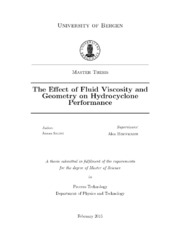The effect of fluid viscosity and geometry on hydrocyclone performance
Master thesis
Permanent lenke
https://hdl.handle.net/1956/9948Utgivelsesdato
2015-02-02Metadata
Vis full innførselSamlinger
Sammendrag
Hydrocyclones have been widely used throughout industries for separating sand particles of various sizes and shape from fluids. Producing petroleum resources includes amounts of water, which contain different amounts of dispersed and dissolved oil and sand that make the process control more difficult. These components can create various problems for the equipment during separation and production and are harmful to the environment. Therefore it is necessary to remove them from the liquids. For these reasons, our knowledge about separation processes as well as equipment has to be improved. Additionally, we have to know which equipment should be used at which stage. The main objective of this project is to advance that work by studying the "removal of particles from highly viscous liquids by using hydrocyclones". To identify an optimal configuration for hydrocyclone performance, the choice was made to modify the hydrocyclone to make it appropriate for highly viscous liquids. The influence of governing geometric variables such as the overflow diameter as well as the conical part length on the separation performance and pressure drop are investigated. On this basis, an experimental rig was built, based on an existing rig, to study the effects of the conical part length and the overflow diameter. Some modifications were made during assembly and after testing the rig. In this thesis, an Eulerian- Eulerian CFD, Reynold Stress Model (RSM) simulation of a solid-liquid hydrocyclone has been performed. The CFD simulation and experimental investigation the separation performance and pressure drop of a hydrocyclone for solid-liquid separation with variations in body dimensions show that the results obtained from the simulation are somewhat different probably due to the CFD model utilized in this thesis. The results from this thesis show that when the viscosity of the liquid is increased, the separation efficiency and the pressure drop decrease and the situation is the same for the tangential and axial velocity. Investigations illustrate that an increase in the conical part length leads to a rise in separation performance, while the pressure drop decreases. The results obtained from the methods indicate that the reduction in overflow diameters result in an increase in the separation efficiency, while this leads to an increase in pressure loss across the hydrocyclone.
